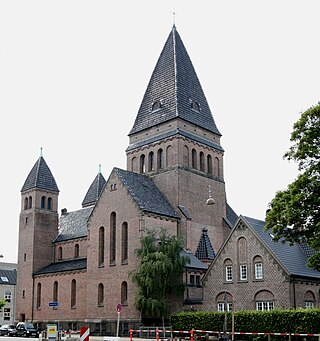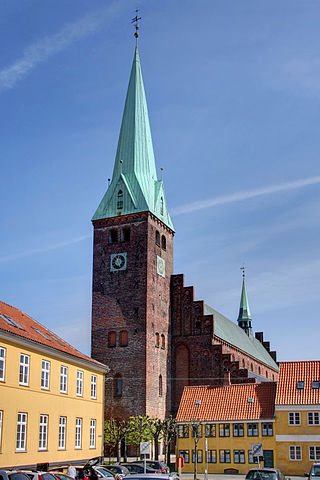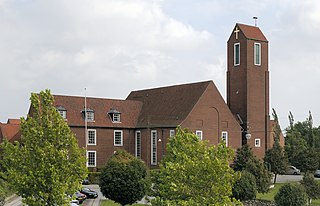
St. Peter's Church is the parish church of the German-speaking community in Copenhagen, Denmark. It is situated at the corner of Nørregade and Sankt Peders Stræde in the city's Latin Quarter. Built as a single-nave church in the mid-15th century, it is the oldest building in central Copenhagen. It is also notable for its extensive complex of sepulchral chapels.

Church frescos or church wall paintings are to be found in some 600 churches across Denmark, no doubt representing the highest concentration of surviving church murals anywhere in the world. Most of them date back to the Middle Ages and were uncovered by Jacob Kornerup (1825–1913) who carried out restoration work in 80 churches across the country towards the end of the 19th century. They lay hidden for centuries as after the reformation, they were covered with limewash only to be revealed and restored during the course of the 19th and 20th centuries. In most of Europe medieval frescos, extremely common in the Middle Ages, were more likely to be removed completely during the Reformation or in subsequent rebuildings, or merely as they aged. The oldest frescos, dating back to the 12th century, were painted in the Romanesque style by artists from elsewhere in Europe but those from the 14th century and thereafter are in the Gothic style which was used by native Danish painters. It is these that are considered to be the most important for Danish art and culture. A distinction is to be made between these church wall paintings or kalkmalerier and the generic term "fresco" which refers to all types of painting on plastered walls or ceilings.

St. Paul's Church is a Lutheran church in central Copenhagen, Denmark, also colloquially known as Nyboder's Church due to its location in the middle of the Nyboder area. It was designed by Johannes Emil Gnudtzmann and constructed from 1872 to 1877.

Isaiah Church is a Lutheran church in the Østerbro district of Copenhagen, Denmark.

St. Mark's Church is a church at the end of Julius Thomsens Plads in the Frederiksberg district of Copenhagen, Denmark.

St. Ib's Church, 3 km south-west of Svaneke on the Danish island of Bornholm, is a fine 12th century Romanesque building. The altarpiece was painted by Christoffer Wilhelm Eckersberg in 1846. The Renaissance pulpit was decorated by Paul Høm in 1964 with ceramics of the four evangelists.

Elijah's Church is a Church of Denmark parish church located on Vesterbros Torv in the heart of the Vesterbro district of Copenhagen, Denmark. Completed in 1908 and designed by Martin Nyrop, who has designed Copenhagen City Hall, it was the largest church to be built by the Copenhagen Church Foundation.

Sankt Ols Kirke, also known as Olsker Church, is a 12th-century round church located in the village of Olsker, 4 km (2.5 mi) south of Allinge on the Danish island of Bornholm. Built in the Romanesque style and reaching three storeys high, it has from the beginning consisted of a round nave, a choir and an apse.

St. Bodil's Church is a parish church dating from the 13th century located in Denmark, 4 km west of Nexø on the Danish island of Bornholm.

St. Peter's Church is a Romanesque parish church some 6 km east of Aakirkeby on the Danish island of Bornholm. It is thought to be the oldest church on the island.

St. Paul's Church is a Romanesque church near Nexø on the Danish island of Bornholm. Unlike similar churches on the island, it has no tower.

Aastrup Church, located on the top of a steep hill in the village of Aastrup, 6 kilometres (3.7 mi) southwest of Stubbekøbing on the Danish island of Falster, dates from c. 1200. Built in the Late Romanesque style, it has frescos from the 13th and 15th centuries.

St Paul's Church is a parish church in Aarhus, Denmark. It was completed in 1887 to a design by Vilhelm Theodor Walther in the Neo-Romanesque style.

Sundby Church is a Church of Denmark parish church located on Amagerbrogade in Copenhagen, Denmark. Completed in 1870 to designs by Hans Jørgen Holm, it is the oldest church on the northern part of Amager.

Saint Olaf's Church is the cathedral church of Helsingør in the north of Zealand, Denmark. With a history going back to around 1200, the present building was completed in 1559. In 1961, the church was given the status of cathedral in connection with the establishment of the Diocese of Helsingør.

St Ib's Church is a Romanesque church in Roskilde on the Danish island of Zealand. It was first mentioned in 1291. The church was once richly decorated with frescos.

Stege Church, also Sankt Hans Church, is a 13th-century brick church in Stege on the Danish island of Møn. Now in the Gothic architectural style, the church was originally a Romanesque building.

St. Lukas Church is a church in Aarhus, Denmark. The church is situated in the Frederiksbjerg neighbourhood on Skt. Lucas Kirkeplads by Ingerslevs Boulevard. St. Lukas Church is a parish church under the Church of Denmark, the Danish state church, under the Diocese of Aarhus. It is the parish church of St. Lukas Parish which has some 11.000 parish members. The church was designed by architects Anton Frederiksen and Kaj Gottlob in neoclassical style with a 35 meters tall tower. It was constructed between 1921 and 1926 but the crypt under the church, with room for 200 graves, was opened before the church itself, in 1923.

St. Mark's Church is a church located in St. Mark's Parish in Aarhus, Denmark. The church is located in the Midtbyen neighbourhood. It is a parish church within the Church of Denmark servicing a parish population of 8.873 (2015). The church was designed by the Danish architect Thomas Havning who won a public contest for a new church design in 1933. The parish of the Church of Our Lady was reaching a population of 10.000 and it had been decided to split it and create a new parish, requiring a new church. Construction began in 1934 and was completed in October, 1935. The church is dedicated to Mark the Evangelist. In 1982 a new wing, Klostergården, was added to the church with an office and recreational facilities for youth preparing for confirmation. In 1998 the church was extensively renovated.

St. Theresa's Church is a Roman Catholic church located at Bernstorffsvej on Hellerup, Gentofte Municipality, Copenhagen, Denmark. It is part of a larger complex which also comprises Rygaards International School.





















